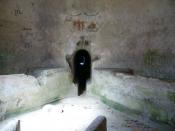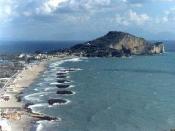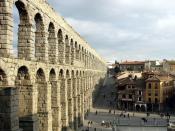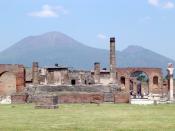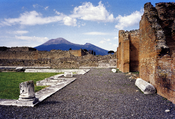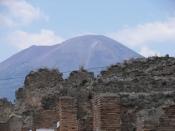The Water Runs Through It Robert Harris? Pompeii is thoroughly researched, informative, and filled with suspense. Attilius, the Aquarius and of the Aqua Augusta, is the main character. Attilius overcomes many obstacles and survives several life and death situations. Through Attilius we learn the ineer workings, technical details, and pictorial descriptions of the Aqua Augusta.
The novel begins on August 22, A.D 79 at 04:21 hours. The twilight overhead turns into blistering heat creating irritable moods and dense air. Attilius is frustrated with his men and dissatisfied with the slow progression of the days work. ?Attilius, an old straw hat pulled low over his face, worked hardest of all. Even when the others crept off occasionally to sprawl in whatever patches of shade they could find, he continued to sway his ax. The shaft was slippery with his sweat and hard to grip. His palms blistered. His tunic stuck to him like a second skin.
But he would not show weakness in front of the men. Even Corax shut up after awhile.? (12) A strong heritage of aqueduct engineers is why Attilius is so knowledgeable of water and the Aqua Augusta. Although Attilius is very young, he is placed in a very important position as Aquarius. Attilius knows every inch of the aqueduct. He maintains, repairs and bonds with the aqueduct. Attilius knows where the aqueduct begins its journey and where all of the pipes are that connect to it. Attilius knows, ?the aqueduct captured the springs of Serinus and bore the water westward ? it channeled it along sinuous underground passages, carried it over ravines on top of tiered arcades, forced it across valleys through massive siphons ? all the way down to the plains of Campania, then around the far side of Mount Vesuvius, then south to the coast at Neopolis, and finally along the spine of the Misenum peninsula to the dusty naval town, a distance of some sixty miles, with a mean drop along her entire length of just two inches every one hundred yards.? (7) He also gives a pictorial detail of where the aqueduct services water supply, ?the Augusta?s serpentine conduit ? the matrix, as they called it: the mother line ? suckled no fewer than nine towns around the Bay of Neopolis: Pompeii first, at the end of a long spur, then Nola, Acerrae, Atella, Neapolis, Puteoli, Cumae, Baiae, and finally Misenum.? (8) This detail allows us to follow where the Aqua Augusta is and the paths that are taken to repair it and to escape the impending doom of Mount Vesevius.
Attilius? aptitude of the aqueduct allows him to approximate when and where the water supply beings to fail. ?He traced it with his finger, his lips moving silently. Two and a half miles an hour! If Nola had gone down at dawn, then Acerrae and Atella would have followed in the middle of the morning. If Neapolis, twelve miles round the coast from Misenum, had lost its supply at noon, then Puteoli?s must have gone at the eighth hour, Cumae?s at the ninth, Baiae?s at the tenth. And now, at last, inevitably, at the twelfth, it was their turn.? (48) This is particularly disturbing to Attilius because of the fact that Pompeii is the first town on the matrix.
The matrix consists of four groups of pyramids around a roofless, circular brick wall, about the height of a man?s waist. ?It was a settling tank.? (188) There are about a dozen of these along the Augusta, ?one very three to four miles was Vitruvius?s recommendation ? places where the water was deliberately slowed to collect impurities as they sank to the bottom. Masses of tiny pebbles, work perfectly round and smooth as they were washed along the matrix, had to be dug out every few weeks and piled beside the aqueduct, to be carted away and either dumped or used for road-building.? (188) Attilius thinks that this is a favorite place to run off a secondary line. He evaluates Pompeii?s final manhole, ?the tank was twenty feet across and he would guess at least fifteen feet deep. With the sun gone it was too dark to see all the way to the gravel floor, but he knew there would be three tunnel mouths down there ? one where the Augusta flowed in, one where it flowed out, and a third connecting Pompeii to the system.? (189) Attilius calculates from this point where the blockage occurs. Attilius says, ?You see that? The way the water is gushing from below? That?s because the main is blocked somewhere further down its course.? (189) Attilius contends with the mystery of the blockage in the Augusta. He continues on his journey by exploring the tunnels underneath the ground. ?Three feet of earth, then two of masonry and then six of nothing from the top of the tunnel roof to the floor. Eleven feet in all. Attilius evaluates his surroundings, ?He turned and lowered himself into the narrow shaft, his fingers holding tight to the top of the manhole, and hung there for a moment, suspended.? (194) Attilius battles his fear of the claustrophobic atmosphere within the deep ground. When he finally has the courage to lower himself further into the ground he bends his knees to absorb the shock. The darkness envelopes him as he reaches outward feeling only the dry cement beneath his fingers. He requests his torch from above and moves on with his inspection. ?The lower part was encrusted with lime deposited by the water over the years. Its roughened, bulging surface looked more like the wall of a cave than anything man-made, and he thought how quickly nature seized back what she had yielded ? brickwork was crumbled by rain and frost, roads were buried under green drifts of weeds, aqueducts were clogged by the very water they were built to carry.?(195) Attilius ponders the question of the power mother nature truly has over man-made structures ? and who will win? Attilius realizes during his inspection that the maintenance on the aqueduct has not been done for at least a decade. Attilius walks slowly along the wall, counting the paces from where he began. ??when he reached eighteen he gave a murmur of surprise. It was not simply that the tunnel was entirely blocked ? he had expected that ? but rather it seemed as if the floor had been driven upward, pushed from below by some irresistible force. The thick concrete bed on which the channel rested had been sheared and a section of it sloped toward the roof.?(195) Through inspection of the aqueduct, Attilius finds the source of the problem. Attilius thinks, ?All his problems would be overcome if he could clear what lay ahead of him.? (200) This thought is truer than Attilius can imagine.
The Aqua Augusta is injured and must be repaired quickly. Attilius realizes after a brief interlude of thought that the water is rising quickly and time is running out. Attilius thinks, ?A small gap was what he needed: a controlled release of pressure from somewhere near the top. At first the brick wouldn?t budge. Then the water started to bubble around it and suddenly it shot through his fingers, propelled by a jet that fired it past his head, so close that it grazed his ear.? (203) The Aqua Augusta floods itself and endangering Attilius? life in the process. ??before a wall of water descended over him, smashing him backward, knocking the torch out of his hand and submerging him in the darkness. He hurtled underwater very fast ? on his back, headfirst ? swept along the tunnel, scrabbling for a purchase on a smooth cement render of the matrix, but there was nothing to grip. The surging current rolled him, flipped him over onto his stomach, and he felt a flash of pain as the rope snapped tight beneath his ribs, folding him and jerking him upward, grazing his back against the roof.? (204) Attilius is in a lot of danger, but he is able to overcome his obstacle. ?His mind was beginning to work again. The backed-up waters were draining away, and because the sluices had been closed in Abellinum twelve hours earlier there was nothing left to replenish them. What remained was being tamed and reduced by the infinitesimal gradient of the aqueduct.? (211) Attilius learns how to survive against nature ? and man-made structures. The Aqua Augusta is repaired after many hours of hard labor.
During the horrific volcanic eruption, Attilius is able to, yet again, escape danger through critical thinking and the Aqua Augusta. ?Attilius reached the corner of the castellum aquae with his head lowered into the stinging wind?? (341) ?Pumice had almost completely buried the door. Only a narrow triangle of wood was showing?? (341) ?He threw himself upon her. They clung to each other in the water. And then there was only scalding heat and the stench of sulfur in the darkness of the aqueduct, directly beneath the city walls.? (341) Attilius? knowledge of the inner-workings, technical details, and pictorial descriptions allows him to escape his fate. Or did it?
